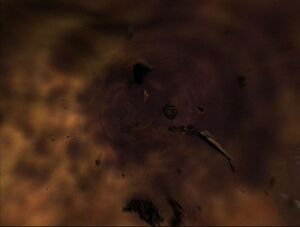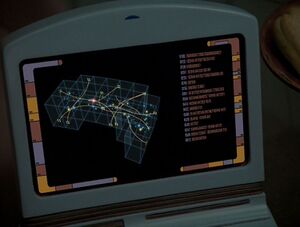Underspace
More actions

The Underspace is a network of subspace corridors extending through large reaches of the Delta Quadrant, allowing swift travel across vast distances. Its use is largely controlled by the Turei Alliance, who have granted Starfleet limited access.
History
The first known users of the Underspace were the Vaadwaur prior to the 15th century. With a reach as far as Talaxian territory, they used the Underspace for trade, exploration, raiding, and expansion, but kept no written records of the phenomenon. When the Vaadwaur were defeated by the Turei and their allies, this understanding and knowledge were lost.
Since then, the Underspace fell broadly into the hands of the Turei. Despite their limited knowledge, they guarded use of the phenomenon jealously, driving out interlopers. One such encounter was with the USS Voyager, who stumbled upon the Underspace by accident and was subsequently instructed to delete from their databanks all evidence of its existence. Despite this fraught first contact, the Starfleet crew ultimately assisted the Turei against a militant group of surviving Vaadwaur, who fled into the Underspace.
This tenuous agreement paved the way for future cooperation between Starfleet and the Turei. In 2399, the Federation formed an agreement that included not only joint operations in the Gradin Belt but limited use of the Underspace for Starfleet ships.
Use of the Underspace

The Turei are familiar with multiple access points to the Underspace in the Gradin Belt, though their knowledge of exits further afield is much more limited. Starfleet has loosely charted routes to the Swallow Nebula, the Nacene Reach, and the Nekrit Expanse, allowing ships to travel to the Delta Quadrant through the Barzan Wormhole and from there proceed across the quadrant.
However, understanding of the Underspace remains limited and much knowledge was lost with the fall of the Vaadwuar. Just as ships have fallen accidentally into the corridors, some have tumbled out before reaching their exits and been left stranded, unable to regain access. Underspace corridors are dotted with the debris of ships lost within, making travel even more dangerous. Travel through the Underspace is not undertaken lightly.
A further restriction comes from Starfleet’s agreement with the Turei. Keen to maintain control of the Underspace, and especially to keep it from the hands of the remaining Vaadwaur, the Turei have not granted the Federation unrestricted access. Starfleet missions through the Underspace must be planned and proposed, demonstrating their necessity before the Turei will provide their essential aid. While the Turei have shown little interest in using this power to influence Starfleet operations, their oversight has limited use of the Underspace to only the most valuable and necessary of missions.
2401
This section is pertinent to the events of the 2024 Fleet Action Labyrinth.
In late-2401, new entry and exit points to Underspace were detected across the known galaxy. Appearing as rifts in subspace, these apertures led to Underspace corridors stretching far further than the network was previously known to extend, potentially enabling travel from the rimward Alpha Quadrant to the furthest reaches of the Delta Quadrant.
This development has brought great chaos with it. Starfleet still understands very little about Underspace, and is unsure if the disruption to space-time is from the mere existence of so many apertures, or some consequence of the mysterious reason for their opening. At present, Underspace is so ill-understood, with its corridors perilous to travel and the routes completely uncharted, leaving Starfleet and anyone else interacting with Underspace in only the earliest stages of deliberately using it.
Apertures
The apertures appear akin to wormholes, though considerably smaller. The new manifestations are exceptionally disruptive, causing intense gravimetric distortions to the surrounding area. This has brought many difficulties to their locales, from their effects on nearby inhabited worlds to the disturbance of other stellar phenomena in proximity. Some have opened in nebulae and agitated the gasses, rendering the space perilous to travel; others have exacerbated or even triggered the manifestation of ion storms. The consequences of their gravimetric distortions and the emissions of tachyon particles from the apertures remain unknown, though Starfleet’s limited understanding of the previously-known apertures in the Delta Quadrant suggests this disturbance may prove temporary, a storm to be weathered.
Multiple ships have stumbled into these apertures. On long-range sensors, they read merely as gravimetric distortions, or the tachyon particles are detected. But in proximity, those gravimetric distortions have pulled unsuspecting ships into Underspace, a process that is often violent and volatile and can cause ships tremendous damage. Some experience ruptures to engines or shields when trying to escape, while others, pulled into Underspace with little warning or preparation, have collided with the debris that litters the corridors. A careful and knowing approach can prepare a crew to avoid being dragged into an Underspace aperture, but even the best can fall foul of this chaotic phenomenon.
Underspace Corridors
Despite the chaotic nature of this expansion, Underspace corridors themselves do not appear particularly more disturbed than past records suggest. This is of small comfort; Underspace has always been volatile. Its corridors are labyrinthine and would take centuries to fully chart; while one expedition may reliably trace a route between apertures, its navigation must be calculated to absolute perfection to avoid traversing the wrong spatial intersect.
This does not account for the dangers in Underspace. Flows of tachyon particles can bring turbulence that could damage a ship, or even force it through a break in the radial wall. It is almost impossible to re-access Underspace in such circumstances, potentially leaving a ship stranded hundreds of light-years from either its origin or destination. Civilisations, particularly the Vaadwaur eight hundred years ago, have used Underspace, wittingly or unwittingly, for centuries. Many of them have fallen prey to its dangers, their ships destroyed, and graveyards of the vessels of people both ancient and modern litter Underspace in debris corridors. Some remains are large enough for study; others have become micro-debris fields that can, again cause chaos for the traveller.
Alterations to a ship’s shield harmonics have, in the past, forced a ship out of the tunnels. The Turei used a resonance pulse to manipulate Voyager’s shields to do just that in Starfleet’s first encounter with Underspace. This could theoretically be used to force another ship out of Underspace or be used deliberately to escape the corridors. Theoretically, the right harmonic calibrations could also keep a ship more secure in Underspace if other disturbances threaten to eject it.
It is, in short, exceptionally difficult to find an intentional destination in Underspace, and even if one is clear of one’s route, the journey itself is perilous.
Underspace Travellers
The recent opening of these apertures across the galaxy has impacted seemingly every stellar traveller, with ships from across the Milky Way stumbling into Underspace and emerging somewhere else, often damaged and confounded.
Retracing one’s footsteps is not as easy as simply coming about and re-entering the aperture. That runs the risk of only becoming lost again. Many crews will interpret Starfleet protocols and their own experiences to consider completing some, if not all of the following steps, before trying to use Underspace to return to their point of origin:
- Ascertaining the exact current location of the ship and aperture. To do so with a sufficiently high degree of accuracy, it is recommended a ship conduct a level 1 astronomical scan, a process that could take several hours, or conduct level 3 scans at three or more locations within precisely one light-year.
- Conduct a full study of all sensor and navigational records of the journey through Underspace to identify the route taken, with consideration for tachyon turbulence or other disruptions which might have affected the journey. This is the sort of task that could take hours or days depending on how thorough a science officer wishes to be.
- Launch a probe into the mouth of the aperture to scan not only for immediate debris or dangers in Underspace, but to chart the ebbs and flows and disruption of tachyon particles. This allows ships to not only mitigate the dangers of Underspace travel, but can help a navigator calculate the route back, compensating for turbulence. This is, again, the sort of task that could take hours or days.
Any ship can of course attempt to immediately retrace their footsteps, and many will not have the luxury of completing the full process. This is, however, how a ship could try to return home with the highest level of certainty and safety. Such protocols will be attempted by lost Starfleet ships, but also are undertaken by Starfleet crews trying to assist other lost travellers.
The speed of travel through Underspace is variable. Some corridors take direct routes to their destination, while others may be more meandering. All are, of course, considerably quicker than warp. In the first encounter with Underspace, Voyager travelled 200 light-years in five minutes (a ten day journey at warp 9.99). It is not unusual for Underspace journeys to last hours or days, however, for routes spanning quadrants - or maybe less!
In Play
- The Underspace allows Starfleet ships to travel swiftly to the furthest reaches of the Delta Quadrant. This is how, along with the Barzan Wormhole, stories can be told across almost all regions Voyager visited on its journey home.
- The Underspace is not a safe or reliable means of travel. Starfleet are wholly reliant on the expertise of the Turei to plan routes, and potentially catastrophic accidents that could strand ships in the depths of the Delta Quadrant remain possible. As such, Starfleet only sends ships through the Underspace on serious and committed exploration missions for months, perhaps years at a time.
- The Underspace is a writing tool to let ships access distant regions. But these restrictions mean those missions are long-term operations in isolated regions, committed missions of deep-space exploration with no easy backup and no quick return to Starfleet or the Federation. It undermines the point of the Underspace if it is used to zip back-and-forth across the Delta Quadrant casually.
- As of the events of Labyrinth, apertures are opening anywhere in the galaxy writers can conceive of.
- Travel time in Underspace is variable. Some corridors may be very direct, some may be more meandering, but are all still vastly quicker than warp. An Underspace journey epitomises 'travelling at the speed of plot.' If you want to travel sixty thousand light-years in a matter of hours, or even less, then your ship just found a very direct and efficient corridor.
